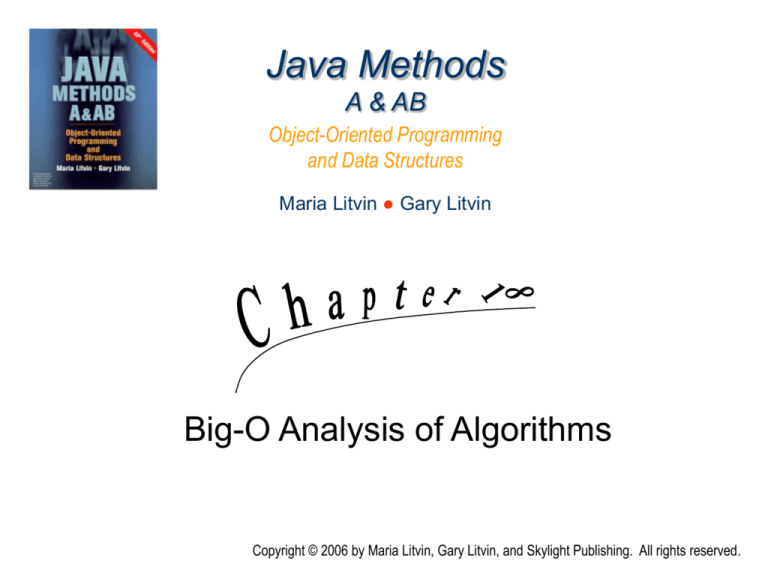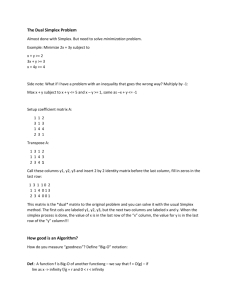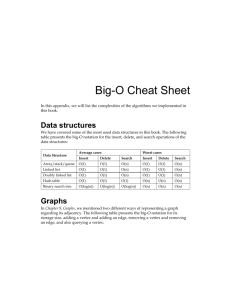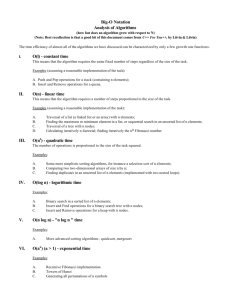
Java Methods
A & AB
Object-Oriented Programming
and Data Structures
Maria Litvin ● Gary Litvin
Big-O Analysis of Algorithms
Copyright © 2006 by Maria Litvin, Gary Litvin, and Skylight Publishing. All rights reserved.
Objectives:
• Learn the big-O definition and notation
• Review big-O for some common tasks
and algorithms studied earlier
• Review several popular sorting
algorithms and their average, best, and
worst case big-O
18-2
Evaluation of Algorithms
• Practice:
benchmarks
t
• Theory:
asymptotic analysis,
big-O
n
18-3
Analysis of Algorithms —
Assumptions
• Abstract computer model with “unlimited”
RAM
• Unlimited range for integers
• Basic operations on integers (addition,
multiplication, etc.) take fixed time regardless
of the values of the operands
18-4
Big-O Analysis
• Studies space and time requirements in
terms of the “size” of the task
• The concept of “size” is somewhat
informal here:
The size of a list or another collection
The dimensions of a 2-D array
The argument of a function (for example,
factorial(n) or fibonacci(n))
The number of objects involved (for example,
n disks in the Tower of Hanoi puzzle)
18-5
Big-O Assumptions
• Here our main concern is time
• Ignores a constant factor
measures the time in terms of the number
of some abstract steps
• Applies to large n, studies asymptotic
behavior
18-6
Example 1: Sequential Search
for (int i = 0; i < n; i++)
if (a[ i ] == target)
break;
n/2 iterations
on average
t (n) tinit titer n / 2
t ( n) A n B
t (n)
B
1
An
An
Small when
n
t
t(n) = An
The average time is
approximately A·n —
linear time (for large n)
n
18-7
Example 2: Binary Search
n The Number of Comparisons
1
3
2
7
3
...
...
n
log2(n)
t (n) tinit titer log 2 n
The average time is
approximately C·log2 n
— logarithmic time
(for large n)
t
t(n) = C log n
n
18-8
Sequential vs. Binary Search
• The logarithmic curve increases without
bound when n increases
• But... log grows much
more slowly than any
linear function.
• No matter what the
constants are, the linear
“curve” eventually
overtakes the
logarithmic curve.
t
n
18-9
Order of Growth
• For large enough n, a binary search on the
slowest computer will finish earlier than a
sequential search on the fastest computer.
• It makes sense to talk about the order of
growth of a function.
• Constant factors are ignored.
For example, the order of
growth of any linear function
exceeds the order of growth of
any logarithmic function
18-10
Big-O
Given two functions t(n) and g(n),
we say that
t(n) = O(g(n))
if there exist a positive constant A
and some number N such that
t(n) A g(n)
for all n > N.
18-11
Big-O (cont’d)
• Big-O means that asymptotically
t(n) grows not faster than g(n).
like “t(n) g(n)”
• In analysis of algorithms, it is
common practice to use big-O
for the tightest possible upper
bound.
like “t(n) = g(n)”
• Example:
Sequential Search is O(n)
Binary Search is O(log n)
18-12
Big-O (cont’d)
• For a log, the base is not important:
from the Change of Base Theorem
logb n K log n
where
1
K
log b
18-13
Big-O (cont’d)
• For a polynomial
k 1
P(n) ak nk ak 1
... a1n a0
the big-O is determined by the
degree of the polynomial:
P(n) O(nk )
18-14
Big-O (cont’d)
• For “triangular” nested loops
for (int i = 0; i < n; i++)
for (int j = i; j < n; j++)
...
The total number of iterations is:
n(n 1)
1 2 ... (n 1)
O( n 2 )
2
18-15
Big-O Examples
• O(1) — constant time
Finding a median value in a sorted array
Calculating 1 + 2 + ... + n using the formula for the
sum of an arithmetic sequence
Push and pop operations in an efficiently
implemented stack; add and remove operations in
a queue (Chapter 21)
Finding a key in a lookup table or a sparsely
populated hash table (Chapter 24)
18-16
Big-O Examples
• O(log n) — logarithmic time
Binary search in a sorted list of n elements
Finding a target value in a binary search
tree with n nodes (Chapter 23)
add and remove operations in a priority
queue, implemented as a heap, with n
nodes (Chapter 25)
18-17
Big-O Examples
• O(n) — linear time
Traversing a list with n elements, (for
example, finding max or min)
Calculating n factorial or the n-th Fibonacci
number iteratively
Traversing a binary tree with n nodes
(Chapter 23)
18-18
Big-O Examples
• O(n log n) — “n log n” time
Mergesort and Quicksort of n elements
Heapsort (Chapter 25)
18-19
Big-O Examples
• O(n2) — quadratic time
More simplistic sorting algorithms, such as
Selection Sort of n elements
Traversing an n by n 2-D array
Finding duplicates in an unsorted list of n
elements (implemented with a nested loop)
18-20
Big-O Examples
• O(an) (a > 1) — exponential time
Recursive Fibonacci implementation
(a 3/2; see Chapter 22)
Solving the Tower of Hanoi puzzle (a =
2; see Section 22.5)
Generating all possible permutations
of n symbols
18-21
Big-O Summary
O(1) < O(log n) < O(n) < O(n log n) < O(n2) < O(n3) < O(an)
t
Exponential:
t = kan
Quadratic:
t = Cn2
n log n
Linear
log n
Constant
n
18-22
Sorting
• O(n2)
• O(n log n)
By counting
Selection Sort
Insertion Sort
Mergesort
Quicksort
Heapsort
If you are limited to “honest”
comparison sorting, any sorting
algorithm, in its worst case scenario,
takes at least O(nlog n) steps
18-23
Sorting by Counting —
2
O(n )
• For each value in the list, count how many values are
smaller (or equal with a smaller index).
• Place that value into the position indicated by the
count.
Always n2
comparisons
for (int i = 0; i < n; i++)
{
count = 0;
for (int j = 0; j < n; j++)
if (a [ j ] < a [ i ] | | (a [ j ] == a [ i ] && j < i ) )
count++;
b [count ] = a [ i ];
}
18-24
Selection Sort —
2
O(n )
• Find the largest value and swap it with the last
element.
• Decrement the “logical” size of the list and repeat
while the size exceeds 1.
while (n > 1)
{
iMax = 0;
for (int i = 1; i < n; i++)
if (a [ i ] > a [ iMax ])
iMax = i;
Always n(n-1)/2
comparisons
swap (a, iMax, n-1);
n--;
}
18-25
Insertion Sort — O(n2)
• Keep the beginning of the list sorted.
• Insert the next value in order into the sorted.
beginning segment.
O(n2) comparisons
on average, but only
O(n) when the list is
already sorted
for (int i = 1; i < n; i++)
{
temp = a [ i ];
for (int j = i; j > 0 && a [ j-1 ] > temp; j--)
a [ j ] = a [ j-1 ];
a [ j ] = temp;
}
18-26
Mergesort — O(n log n)
• Split the list down the middle into two lists of
approximately equal length.
• Sort (recursively) each half.
• Merge the two sorted halves into one sorted list.
private void sort (double a [ ], int from, int to)
{
if (to == from)
return;
Each merge
takes O(n)
int middle = (from + to) / 2;
comparisons
sort(a, from, middle);
sort(a, middle + 1, to);
merge (a, from, middle, middle + 1, to);
}
18-27
Quicksort — O(n log n)
• Choose a “pivot” element.
• Partition the array so that all the
values to the left of the pivot are
smaller than or equal to it, and all
the elements to the right of the
pivot are greater than or equal to it.
• Sort (recursively) the left-of-thepivot and right-of-the-pivot pieces.
Proceed from
both ends of the
array as far as
possible; when
both values are
on the wrong side
of the pivot, swap
them
O(n log n) comparisons,
on average, if partitioning
splits the array evenly
most of the time
18-28
Heapsort — O(n log n)
• An elegant algorithm based on heaps
(Chapter 25)
18-29
Sorting Summary
Best case
Average case
Worst case
Selection Sort
O(n2)
O(n2)
O(n2)
Insertion Sort
O(n) — array
already sorted
O(n2)
O(n2)
Mergesort
O(n log n), or O(n)
in a slightly
modified version
when the array is
sorted
O(n log n)
O(n log n)
Quicksort
O(n log n)
O(n log n)
O(n2) — pivot is
consistently chosen far
from the median value,
e.g., the array is already
sorted and the first
element is chosen as
pivot
Heapsort
O(n log n)
O(n log n)
O(n log n)
18-30
Review:
• What assumptions are made for big-O
analysis?
• What O(...) expressions are commonly used
to measure the big-O performance of
algorithms?
Is it true that n(n-1)/2 = O(n2)?
•
• Give an example of an algorithm that runs in
O(log n) time.
• Give an example of an algorithm (apart from
sorting) that runs in O(n2) time.
18-31
Review (cont’d):
• Name three O(n log n) sorting algorithms.
• How many comparisons are needed in
sorting by counting? In Selection Sort?
•
•
•
•
What is the main idea of Insertion Sort?
What is the best case for Insertion Sort?
What is the main idea of Quicksort?
What is the worst case for Quicksort?
18-32







